Showing Spotlights 2033 - 2040 of 2780 in category All (newest first):
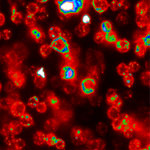 DNA nanomachines - synthetic DNA assemblies that switch between defined molecular shapes upon stimulation by external triggers - can be controlled by a variety of methods; these include pH changes and the addition of other molecular components, such as small molecule effectors, proteins and DNA strands. A team of Indian researchers has now taken structural DNA nanotechnology, where so far only in vitro applications have been demonstrated, across a new boundary and into living systems. They describe the successful operation of an artificially designed DNA nanomachine inside living cells, and show that these nanomachines work as efficiently inside cells as in vitro. The device is externally triggered by protons and functions as a pH sensor based on fluorescence resonance energy transfer (FRET) inside living cells.
DNA nanomachines - synthetic DNA assemblies that switch between defined molecular shapes upon stimulation by external triggers - can be controlled by a variety of methods; these include pH changes and the addition of other molecular components, such as small molecule effectors, proteins and DNA strands. A team of Indian researchers has now taken structural DNA nanotechnology, where so far only in vitro applications have been demonstrated, across a new boundary and into living systems. They describe the successful operation of an artificially designed DNA nanomachine inside living cells, and show that these nanomachines work as efficiently inside cells as in vitro. The device is externally triggered by protons and functions as a pH sensor based on fluorescence resonance energy transfer (FRET) inside living cells.
Apr 9th, 2009
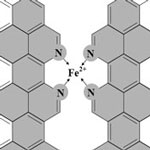 New work by this Canadian research team has now demonstrated that it is possible to significantly increase the catalytic site density of iron-based non-precious metal catalysts (NPMCs) to levels that were not thought possible before. The problem that this work resolves is that of the low activity of NPMCs compared to platinum-based catalysts. The best of these new NPMCs is more than 30 times more active compared to the previous best reported activity for NPMCs, and about 100 times more active than the majority of other NPMCs. Furthermore, their activity has reached about 1/10th the volumetric activity of state-of-the-art platinum-based catalysts (about 50 wt% platinum on carbon), which is the 2010 NPMC activity target set by the U.S. Department of Energy.
New work by this Canadian research team has now demonstrated that it is possible to significantly increase the catalytic site density of iron-based non-precious metal catalysts (NPMCs) to levels that were not thought possible before. The problem that this work resolves is that of the low activity of NPMCs compared to platinum-based catalysts. The best of these new NPMCs is more than 30 times more active compared to the previous best reported activity for NPMCs, and about 100 times more active than the majority of other NPMCs. Furthermore, their activity has reached about 1/10th the volumetric activity of state-of-the-art platinum-based catalysts (about 50 wt% platinum on carbon), which is the 2010 NPMC activity target set by the U.S. Department of Energy.
Apr 8th, 2009
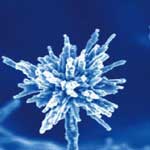 NIOSH, the National Institute for Occupational Safety and Health in the United States, has published the final version of its report 'Approaches to Safe Nanotechnology'. This document reviews what is currently known about nanoparticle toxicity, process emissions and exposure assessment, engineering controls, and personal protective equipment. This updated version of the document incorporates some of the latest results of NIOSH research, but it is only a starting point. The document serves a dual purpose: it is a summary of NIOSH's current thinking and interim recommendations; and it is a request from NIOSH to occupational safety and health practitioners, researchers, product innovators and manufacturers, employers, workers, interest group members, and the general public to exchange information that will ensure that no worker suffers material impairment of safety or health as nanotechnology develops.
NIOSH, the National Institute for Occupational Safety and Health in the United States, has published the final version of its report 'Approaches to Safe Nanotechnology'. This document reviews what is currently known about nanoparticle toxicity, process emissions and exposure assessment, engineering controls, and personal protective equipment. This updated version of the document incorporates some of the latest results of NIOSH research, but it is only a starting point. The document serves a dual purpose: it is a summary of NIOSH's current thinking and interim recommendations; and it is a request from NIOSH to occupational safety and health practitioners, researchers, product innovators and manufacturers, employers, workers, interest group members, and the general public to exchange information that will ensure that no worker suffers material impairment of safety or health as nanotechnology develops.
Apr 7th, 2009
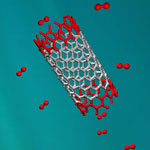 Notwithstanding the tremendous amount of research that has gone into the field of carbon nanotubes, the synthesis of single-walled carbon nanotubes (SWCNTs) with controlled chirality still has not been achieved. Current production methods for carbon nanotubes result in units with different diameter, length, chirality and electronic properties, all packed together in bundles, and often blended with some amount of amorphous carbon. The separation of nanotubes according to desired properties remains a technical challenge. Especially SWCNT sorting is a challenge because the composition and chemical properties of SWCNTs of different types are very similar, making conventional separation techniques inefficient. Using the concept of cloning, scientists in China have discovered an effective method to synthesize any special indices SWCNTs.
Notwithstanding the tremendous amount of research that has gone into the field of carbon nanotubes, the synthesis of single-walled carbon nanotubes (SWCNTs) with controlled chirality still has not been achieved. Current production methods for carbon nanotubes result in units with different diameter, length, chirality and electronic properties, all packed together in bundles, and often blended with some amount of amorphous carbon. The separation of nanotubes according to desired properties remains a technical challenge. Especially SWCNT sorting is a challenge because the composition and chemical properties of SWCNTs of different types are very similar, making conventional separation techniques inefficient. Using the concept of cloning, scientists in China have discovered an effective method to synthesize any special indices SWCNTs.
Apr 3rd, 2009
 Not surprisingly, it has been scientists in The Netherlands - a country that has long been conducting large-scale and long-term field studies on the benefits of certain plants to mental and physical health (scientists refer to this effort as the 'great coffee house smoke screen studies') - that have come up with a nanotechnology discovery that could well revolutionize many consumer products from food to toys. In a report released today, April 1, the Dutch scientists report that a nanoparticulate substance found in Cannabis sativa, also know as marijuana, has an amazing ability to kill fat cells in the human body. Hoping to ride an early wave of commercialization, the Dutch research group has already filed for patent protection and registered the trademark 'Royal Spliffmeister Edition' for a range of planned products.
Not surprisingly, it has been scientists in The Netherlands - a country that has long been conducting large-scale and long-term field studies on the benefits of certain plants to mental and physical health (scientists refer to this effort as the 'great coffee house smoke screen studies') - that have come up with a nanotechnology discovery that could well revolutionize many consumer products from food to toys. In a report released today, April 1, the Dutch scientists report that a nanoparticulate substance found in Cannabis sativa, also know as marijuana, has an amazing ability to kill fat cells in the human body. Hoping to ride an early wave of commercialization, the Dutch research group has already filed for patent protection and registered the trademark 'Royal Spliffmeister Edition' for a range of planned products.
Apr 1st, 2009
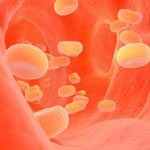 Millions of people with high cholesterol levels are treated with anti-hypolipidemic drugs based on statins that are commonly used to inhibit cholesterol synthesis and lower its serum level. Unfortunately, statins can have two major side effects, although they occur relatively rarely: raised liver enzymes and skeletal muscle pain or even damage. Pharmaceutical research efforts are therefore underway to develop alternative compounds that avoid these potential problems. A promising drug that works via a different mechanism than statin-based drugs, Probucol (PBC), has several advantages over other drugs - better acceptance, ease of administration, and it is much cheaper. Its downside is that its solubility is extremely poor, which considerably lowers its efficiency to suppress cholesterol. A Japanese-U.S. team has now shown that a nanoparticle processing approach enhances the bioavailability of PBC and they demonstrate the design of a solid dosage form for practical use.
Millions of people with high cholesterol levels are treated with anti-hypolipidemic drugs based on statins that are commonly used to inhibit cholesterol synthesis and lower its serum level. Unfortunately, statins can have two major side effects, although they occur relatively rarely: raised liver enzymes and skeletal muscle pain or even damage. Pharmaceutical research efforts are therefore underway to develop alternative compounds that avoid these potential problems. A promising drug that works via a different mechanism than statin-based drugs, Probucol (PBC), has several advantages over other drugs - better acceptance, ease of administration, and it is much cheaper. Its downside is that its solubility is extremely poor, which considerably lowers its efficiency to suppress cholesterol. A Japanese-U.S. team has now shown that a nanoparticle processing approach enhances the bioavailability of PBC and they demonstrate the design of a solid dosage form for practical use.
Mar 31st, 2009
 Much effort has been invested into finding a non-toxic replacement for semiconductor quantum dots (Q-dots) possessing bright fluorescence. Intrinsic toxicity of Q-dots composed of elements such as selenium, tellurium, cadmium, and lead severely hinders their in vivo applications for fluorescent imaging. Therefore many carbon nanomaterials have been considered as a replacement for Q-dots for in vivo imaging. However, it is still unclear how safe carbon nanomaterials are, and this is an obstacle for their use in medicine. Nanodiamond has been an exception among nanomaterials in many aspects, but what is important for biomedical applications is that it has shown very little or zero toxicity in all tests done so far. In addition, nanodiamond powders are already produced by detonation on a large commercial scale. This is why fluorescent nanodiamonds currently attract so much attention.
Much effort has been invested into finding a non-toxic replacement for semiconductor quantum dots (Q-dots) possessing bright fluorescence. Intrinsic toxicity of Q-dots composed of elements such as selenium, tellurium, cadmium, and lead severely hinders their in vivo applications for fluorescent imaging. Therefore many carbon nanomaterials have been considered as a replacement for Q-dots for in vivo imaging. However, it is still unclear how safe carbon nanomaterials are, and this is an obstacle for their use in medicine. Nanodiamond has been an exception among nanomaterials in many aspects, but what is important for biomedical applications is that it has shown very little or zero toxicity in all tests done so far. In addition, nanodiamond powders are already produced by detonation on a large commercial scale. This is why fluorescent nanodiamonds currently attract so much attention.
Mar 30th, 2009
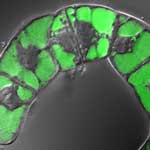 Carbon nanotubes (CNTs) have already been explored as drug carriers into mammalian cells. Compared to nanoparticles, CNTs have a larger inner volume which allows more drug molecules to be encapsulated, and this volume is more easily accessible because the end caps can be easily removed, and they have distinct inner and outer surfaces for functionalization. In addition to nanomedicine applications, plant science research focusing on investigation of plant genomics and gene function as well as improvement of crop species has become a nanotechnology frontier. To what degree nanomaterials can be employed in delivering payloads into plant cells is a subject that has not yet been explored very well although there appears to be demand from plant cell biologists to take advantage of nanomaterials.
Carbon nanotubes (CNTs) have already been explored as drug carriers into mammalian cells. Compared to nanoparticles, CNTs have a larger inner volume which allows more drug molecules to be encapsulated, and this volume is more easily accessible because the end caps can be easily removed, and they have distinct inner and outer surfaces for functionalization. In addition to nanomedicine applications, plant science research focusing on investigation of plant genomics and gene function as well as improvement of crop species has become a nanotechnology frontier. To what degree nanomaterials can be employed in delivering payloads into plant cells is a subject that has not yet been explored very well although there appears to be demand from plant cell biologists to take advantage of nanomaterials.
Mar 27th, 2009
 DNA nanomachines - synthetic DNA assemblies that switch between defined molecular shapes upon stimulation by external triggers - can be controlled by a variety of methods; these include pH changes and the addition of other molecular components, such as small molecule effectors, proteins and DNA strands. A team of Indian researchers has now taken structural DNA nanotechnology, where so far only in vitro applications have been demonstrated, across a new boundary and into living systems. They describe the successful operation of an artificially designed DNA nanomachine inside living cells, and show that these nanomachines work as efficiently inside cells as in vitro. The device is externally triggered by protons and functions as a pH sensor based on fluorescence resonance energy transfer (FRET) inside living cells.
DNA nanomachines - synthetic DNA assemblies that switch between defined molecular shapes upon stimulation by external triggers - can be controlled by a variety of methods; these include pH changes and the addition of other molecular components, such as small molecule effectors, proteins and DNA strands. A team of Indian researchers has now taken structural DNA nanotechnology, where so far only in vitro applications have been demonstrated, across a new boundary and into living systems. They describe the successful operation of an artificially designed DNA nanomachine inside living cells, and show that these nanomachines work as efficiently inside cells as in vitro. The device is externally triggered by protons and functions as a pH sensor based on fluorescence resonance energy transfer (FRET) inside living cells.
 Subscribe to our Nanotechnology Spotlight feed
Subscribe to our Nanotechnology Spotlight feed





